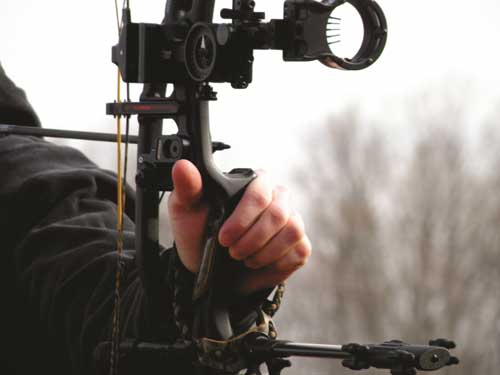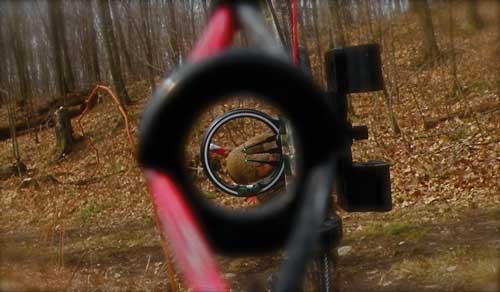Mistake # 1: Bow Torque
The bow grip is where everything begins. Before you purchase a bow, examine the grip's fit and feel. If anything feels "wrong," move on to the next bow.
If you bow you already has an incorrect hand feel, your options are: 1.) Sell the bow and get a different one. 2.) Purchase a more comfortable aftermarket grip. 3.) Take the existing grip (if it's wood) and have a carpenter sand and shape it to your hand.
Once you have a grip that fits, work on how you grip the bow. Torque results when you use your whole hand to grip the bow. The more of your hand you use, the more likely you are to torque the bow. Identify this problem by glancing at the top wheel or cam on your bow at full draw. If the bowstring doesn't line up perfectly with the cam groove, your arrow will not exit the bow true.
 Mistake # 2: Faulty Anchor Point
Mistake # 2: Faulty Anchor Point
Inconsistent anchoring is typical when shooting from a treestand or other awkward positions. On stands, bulky clothing and failure to bend at the waist are common aim-robbing culprits.
Combat this problem by installing a peep sight that allows you to see the entire scope housing on your sight, nothing more. Then when you hit full draw, you can verify your anchor point quickly by centering your scope housing in your peep.
If this is not enough, install a kisser button. A kisser button makes it nearly impossible to achieve a foreign anchor point at the moment of truth. The only downside is losing a couple feet per second.
 Mistake # 3: Bowstring Slap
Mistake # 3: Bowstring Slap
When dressing for cold conditions, bulky clothing gets in the way. If the string slaps your sleeve, it will affect the impact spot of your arrow. If you aren't getting the clearance you need, buy some form of an armguard that will shrink the bulk of your sleeve. Another cure is a string suppression system. These effective devices dissipate string oscillation, stopping your bowstring at its true brace height and short of your sleeve.
A draw length that is too long can amplify string slap. The farther you extend your bow arm at full draw, the more likely you are to hit your sleeve. Consult an archery pro shop and get your draw length spot-on to avoid an arrow-steering string slap.
Mistake # 4: Too Much Draw Weight
A common mistake is shooting too heavy a draw weight, which amplifies bow torque. Frigid temps, stiff muscles, and awkward hunting shots increase the difficulty in drawing. Turn the weight down, shoot sharp broadheads, make sure your bow is well-tuned, and you will be just fine.
Mistake #5: Trigger Punching
Anytime we force something to happen, the outcome is never natural. This is especially true while executing a shot. Forcing the trigger to cut the shot loose simply doesn't allow for good execution and follow-through. Everything about a shot sequence should be natural.
Compare this to baseball. You get the best hit if you follow through once the bat cracks the ball. If you stop your swing as soon as the ball hits, the ball simply won't go as far. So, if you punch your release, the shot doesn't execute naturally, resulting in sloppy follow-through. For best results, squeeze your shot off and allow a natural follow-through.
Mistake #6: Failure To Practice With Broadheads
Think your broadheads shoot exactly like your field points? Think again. This is the biggest area where equipment may legitimately be the blame for a miss. Designate a couple of your chosen broadheads strictly for practice, and use the others for hunting.
Mistake #7: Taking A Bad Shot
The effects of tree limbs, misjudged distances, and poor shot angles multiply when a hunter forces a shot. As tempting as it is to take a low-percentage, unethical shot, letting that animal walk without releasing an arrow may be your best chance of taking that trophy someday.
Each of the above mistakes is controllable. Fix them so they don't shatter your next big shot opportunity!






